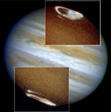|
Links to Aurora-Related Sites |
|
|
|
|
 |
Auroras: Paintings in the Sky (http://www.exploratorium.edu/learning_studio/auroras/) at the Exploratorium. Learn about the Northern Lights on a self-guided tour. Lots of photos and ideas for bringing the Aurora into the classroom. | |
| The Northern Lights Photo Tour (http://www.go2net.org/frame/frametour.html) Gorgeous color photos illustrate this brief history of auroral science. | ||
| Marshall Space Flight Center's Space Plasma Physics Branch (http://science.msfc.nasa.gov/ssl/pad/sppb/index_Edu.html) brings you the science behind the aurora and the facts behind its impact on modern technology, such as global telecommunications. | ||
 |
The Jovian Auroras (http://oposite.stsci.edu/pubinfo/pr/96/32.html) The Hubble Space Telescope reveals Jupiter's auroras. | |
| Listening to the Northern Lights (http://www.npr.org/programs/lnfsound/onair/990326.onair.html) The sounds of Natural Radio brings you the work of Steve McGreevy whose recordings of the Earth's magnetic fields durning auroral showers are featured on Lost and Found Sound (http://www.npr.org/programs/lnfsound/). | ||
| Sounds of the Magnetoshpere at the University of Iowa (http://listen.to/space-audio) Let this site explain these phonomena as you listen to the sounds of polar plasma events such as whistlers and saucers. | ||
| Solar Max 2000 (http://www-istp.gsfc.nasa.gov/istp/outreach/solarmax/index.html) This site is dedicated to bringing you the latest on magnetic storms that will be reaching Earth as we enter the 23rd solar maximum. | ||
| International Solar-Terrestrial Physics (http://www-istp.gsfc.nasa.gov/) This comprehensive site explores the conncection between the Sun and Earth, including the breathtaking auroral phenomenon. | ||
| The Poker Flat Research Range (http://dac3.pfrr.alaska.edu:80/~pfrr/INDEX.HTM) One of FAST's primary ground-to-air contacts, it is the world's only rocket launching facility owned by a university (University of Alaska, Fairbanks) and is home to many instruments designed to study the polar atmosphere and ionosphere. | ||
| University of Alaska, Fairbanks: The Aurora (http://dac3.pfrr.alaska.edu:80/~pfrr/AURORA/) Information, images, regular auroral predictions, classroom activities, and more... | ||
| The Ozone Hole Tour (http://www.atm.ch.cam.ac.uk/tour/) The Centre for Atmospheric Science at the University of Cambridge explains the devastating impact of the depletion of the Earth's ozone layer over polar regions. | ||
| Our Sun Boils! Solar Max
and the Great Northern Lights (http://www.go2net.org/brew/max.html) This article discusses the 23rd solar "max",
the peak of the sunspot cycle, and its effect on our home planet and its inhabitants. Alaska Currents Magazine (http://www.go2net.org/) has put together several other interesting articles online, complete with an aurora forecast (http://www.go2net.org/cur/aurora.html). |
||
| University of Minnesota Space Physics Educational Resources (http://ham.space.umn.edu/spacephys/education.html) This space is currently under development. | ||